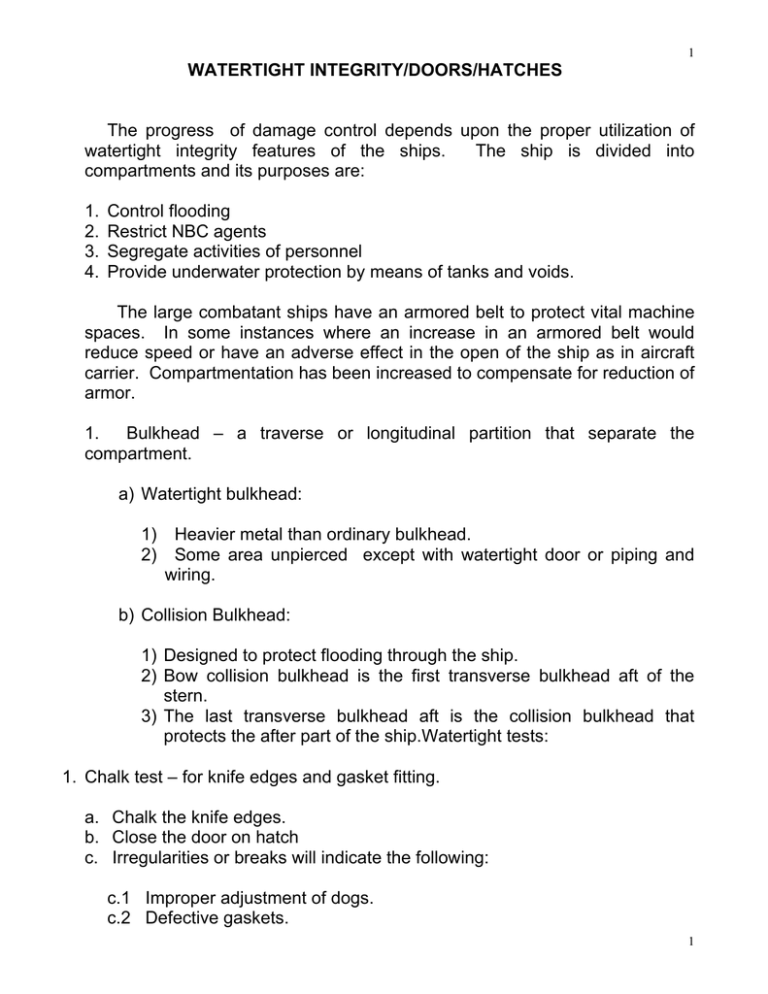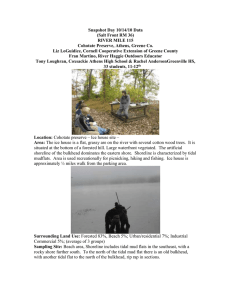WATERTIGHT INTEGRITY/DOORS/HATCHES The progress of
advertisement

1 WATERTIGHT INTEGRITY/DOORS/HATCHES The progress of damage control depends upon the proper utilization of watertight integrity features of the ships. The ship is divided into compartments and its purposes are: 1. 2. 3. 4. Control flooding Restrict NBC agents Segregate activities of personnel Provide underwater protection by means of tanks and voids. The large combatant ships have an armored belt to protect vital machine spaces. In some instances where an increase in an armored belt would reduce speed or have an adverse effect in the open of the ship as in aircraft carrier. Compartmentation has been increased to compensate for reduction of armor. 1. Bulkhead – a traverse or longitudinal partition that separate the compartment. a) Watertight bulkhead: 1) 2) Heavier metal than ordinary bulkhead. Some area unpierced except with watertight door or piping and wiring. b) Collision Bulkhead: 1) Designed to protect flooding through the ship. 2) Bow collision bulkhead is the first transverse bulkhead aft of the stern. 3) The last transverse bulkhead aft is the collision bulkhead that protects the after part of the ship.Watertight tests: 1. Chalk test – for knife edges and gasket fitting. a. Chalk the knife edges. b. Close the door on hatch c. Irregularities or breaks will indicate the following: c.1 Improper adjustment of dogs. c.2 Defective gaskets. 1 2 c.3 Wear and closure of frame. c.4 Worn out places along theknife edges. d. Repair and repeat test until results are satisfactory. 2. Visual Test: a. Every six months b. For compartment that cannot be tested. b.1 Darken the interior of the compartment to be tested. b.2 Have a lighting on the outside of compartment. b.3 Check from the outside for light showing through. 3. Air Test – Compartment designated for air test should be tested every 18 months. a. b. c. d. Close all fittings in the compartment. Put the compartment under pressure. Observe the drop in air pressure. In case of leaks, repair and repeat air test until satisfactory result is obtained. Doors and Hatches: Enclosures for bulkhead opening. They are constructed such they will be as structurally strong as the bulkhead where they are installed. 1. Watertight doors a. Used in watertight bulkhead on second deck and below. b. Designed to resist 1 ½ times as much pressure as the bulkhead it services. c. Has 6 to 12 dogs for securing. c.1 Some dogs must be secured individually. c.2 Usually a hand wheel is used for quick closing of the door. 2. Non-watertight Doors a. Used on non-watertight bulkheads. b. Usually they have fewer dogs than watertight doors and are made of dogs which require individual protection. 2 3 3. Airtight Doors a. Are also fume and gas tight. b. When used in locks, hand wheel is provided for quick closing. c. When used in other places, individual dogs are provided. 4. Spray tight Doors – topside on ships with low freeboard to prevent entry of spray and water. 5. Panel Doors – ordinary metal joined doors to provide privacy in wardrooms, etc. 6. Hatches – are merely horizontal doors which are used for access through decks. 7. Escape scuttle – a round opening quick acting closure placed in a hatch. 8. Manholes a. Are really miniature hatches which are provided in deck for occasional access to water and fuel tanks. b. Bolted manholes are merely section of steel plates which are gasketed and bolted over deck access opening. c. Manholes are also found in bulkheads but are not so common as deck manholes. Closure Fitting And Gaskets: 1. Gasket a. Made of rubber installed on doors and hatches. b. Close against knife edges to form a water tight fitting and form air and gas tight fitting. c. Must be kept free of dirt and grease. 2. Knife edges a. Built out from decks and bulkheads. b. Gasket on watertight doors and hatches close on knife edges. 3. Dogs and Pins a. Pins – are used to connect dogs to the deck or bulkheads. b. Dogs – are used to make closure. 4. Apply a light coat of heavy oil on dogs and pins. 3
